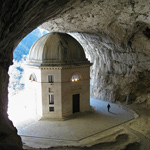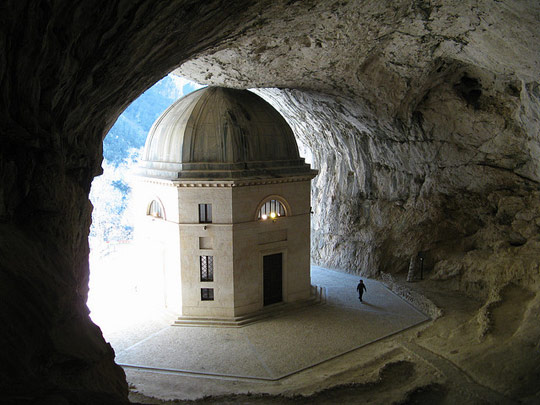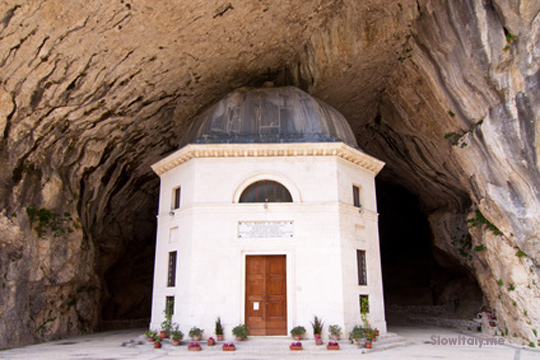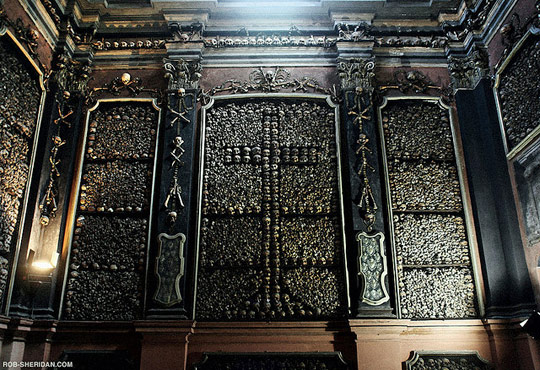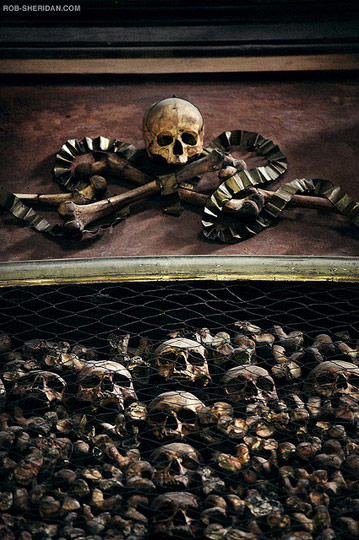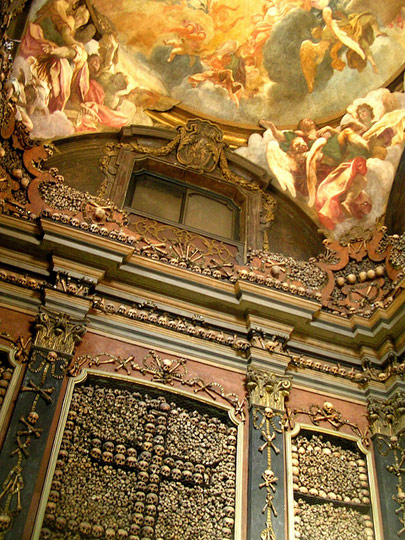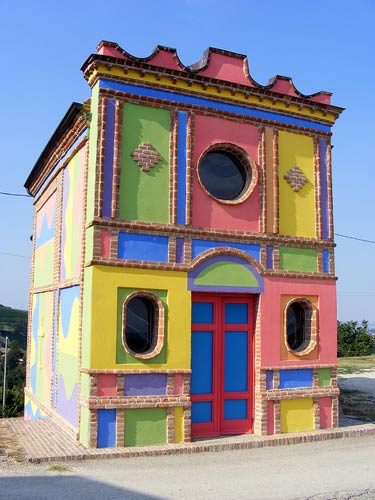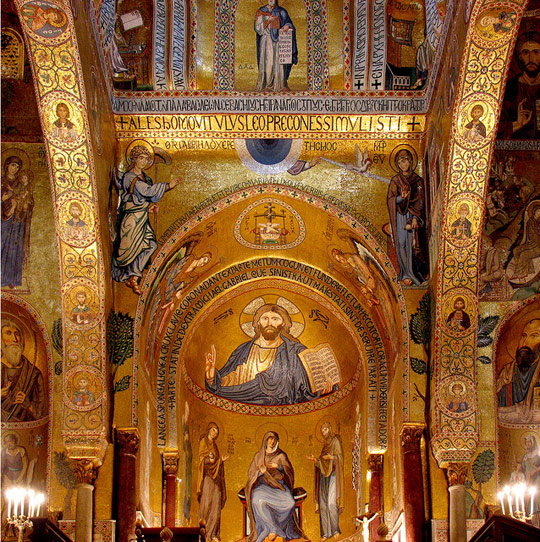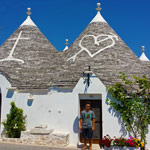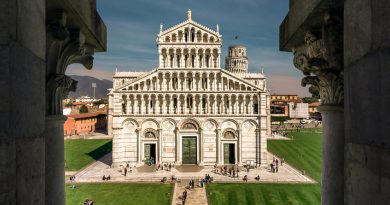Top 5 most amazing and unusual Chapels in Italy
1. Cave chapel of Genga (Marche)
In 1971 a group of speleologists from Ancona discovered a complex system of remarkable karst caves in the municipality of Genga. The cave system, known as Frasassi grottos, is the largest in Europe. The grottos owe their name to the Hermitage Sanctuary of Santa Maria infra saxa, dug in the rock at the entrance of the caves, which pronounced by the locals over time became ‘frasassi’.
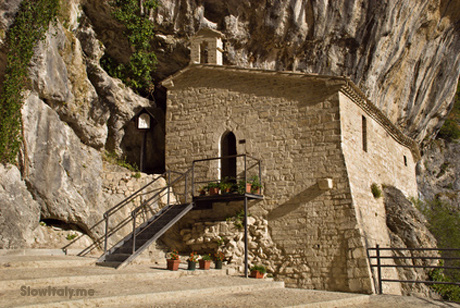
At about 1.5 km from the entrance of the main Frasassi cave is a cavity called Grotta del Santuario, inside which is the Tempietto del Valadier, a chapel designed by the neoclassicist architect Giuseppe Valadier in 1828 for Pope Leo XII. The Chapel with octagonal plan was constructed with white travertine blocks, which were quarried inside the cave.
2. Ossuary Chapel, Milan (Lombardy)
Despite being in the heart of Milan, the remarkable chapel of the Church of San Bernardino alle Ossa is still relatively unknown. This is probably due to the fact that the entrance of the chapel is located inside the modest Church of San Bernardino alle Ossa.
On his visit to Italy in 1738, King John V of Portugal was so struck by the unusual beauty of the chapel that he had an identical one built at Évora, near Lisbon.
The interior of the chapel is entirely decorated with skulls and bones relocated from the cemetery in front of Basilica Santo Stefano Maggiore. The cemetery, laid out in 1140, was filled with bodies from the new hospital built nearby, but soon proved to be insufficient and a chamber was erected in 1210 to house the bones.The church next to it was constructed 60 years later and restructured in 1679 and 1712.
The interior of the ossuary follows an octagonal plan, with Rococo-style decorated niches and doors that surprisingly mix well with the macabre elements. The chapel’s vault was frescoed in 1695 by Sebastiano Ricci with a Triumph of Souls and Flying Angels.
3. Multi-colored vineyard chapel in La Morra (Piedmont)
The Cappella Santa Maria delle Grazie is an unusually colorful chapel located outside the medieval village of La Morra on a vineyard in Brunate, one of Barolo’s most famous crus. Built in 1914 as a shelter for people working in the surrounding vineyards, the chapel had never been consecrated.
In 1999, the family of winemakers who owns the vineyard decided to infuse new life into the forgotten place of worship and commissioned two artists to renovate the little church. Using lively and contrasting colors, the two artists turned the place into a wonderful example of contemporary art, now known as Cappella delle Brunate in celebration to the vineyard to which it belongs. See also: Multicolored vineyard chapel in La Morra.
4. Cappella Palatina, Palermo (Sicily)
The Palatine chapel in Palermo is of such unparalleled splendor that it would deserve an article of its own. It is one of the most striking examples of medieval art still in existence and one of the finest examples of integration of architecture and figurative art. The mosaics of the Palatine Chapel are of unsurpassed refinement and, along with those of Constantinople and Ravenna, count among the finest in Europe.
Built in 1130 and consecrated in 1140, the Cappella Palatina is situated on the ground floor of the Palazzo dei Normanni (also known as Palazzo Reale), seat of the regional Parliament of Sicily. The amazing thing about the Palatine chapel is the way in which it harmoniously combines a variety of styles and influences: the Norman architecture and door decoration, the Arabic arches (muqarnas) and scripts adorning the roof, the Christian symbols, the Orthodox iconography and Byzantine dome.

The magnificent mosaics were completed under successive rulers at different stages in time, the earliest ones in the sanctuary being of the great Byzantine tradition, while the mosaics outside the chapel are from the 19th century, with samples of the various traditions in between. An example of the surprising harmony between the different styles are the clusters of four eight-pointed stars, typical of traditional Arabic design, which are arranged on the ceiling so as to form a Christian cross.
5. The unusual End-of-the-World frescoes of the San Brizio Chapel, Orvieto (Umbria)
The Chapel of the Madonna of San Brizio, added to the Cathedral of Orvieto in the 15th century, is unique both for the quality and for the speed of execution of its frescoes. The frescoes were executed by Luca Signorelli in only two years, between 1500 and 1503, with a speed and efficiency that is virtually unique in the history of Italian art.
The massive work by Signorelli is unusual in many respects. His series of frescoes representing the Apocalypse and the Last Judgment is considered one of the most uncommon artistic expressions of the early Renaissance. No other artist had previously presented such a variety of sharply portrayed nude figures in compositions on such a large scale.
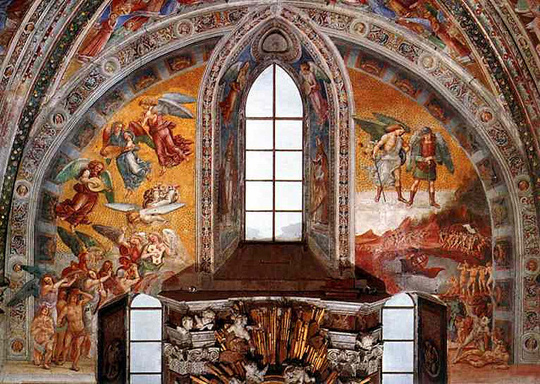
His fresco cycle is full of humor, surprising and grotesque inventions, and erotic allusions. Signorelli’s inventiveness is particularly visible in the scenes ‘Resurrection of the Flesh’, the ‘Damned’, the ‘Elect’, ‘Paradise’ and ‘Hell’.

Also uncommon is the preaching of the Antichrist, which is a highly unusual theme, almost never represented in Italian art.
Photo credits (top to bottom): Genga cave chapel by kermit965, Hermitage Santa Maria © Alvise Dorigo/Fotolia; Genga cave chapel © Markus Bormann/Fotolia; ossuary by Rob Sheridan, Samuele Ghilardi, Rob Sheridan, Wockerjabby; Sciura Pina; Cappella Palatina by Giovencato, Dimitry B; honeycomb ceiling by Aillie_Caulfield; Last judgment, Hell, Antichrist by alarcowa.

